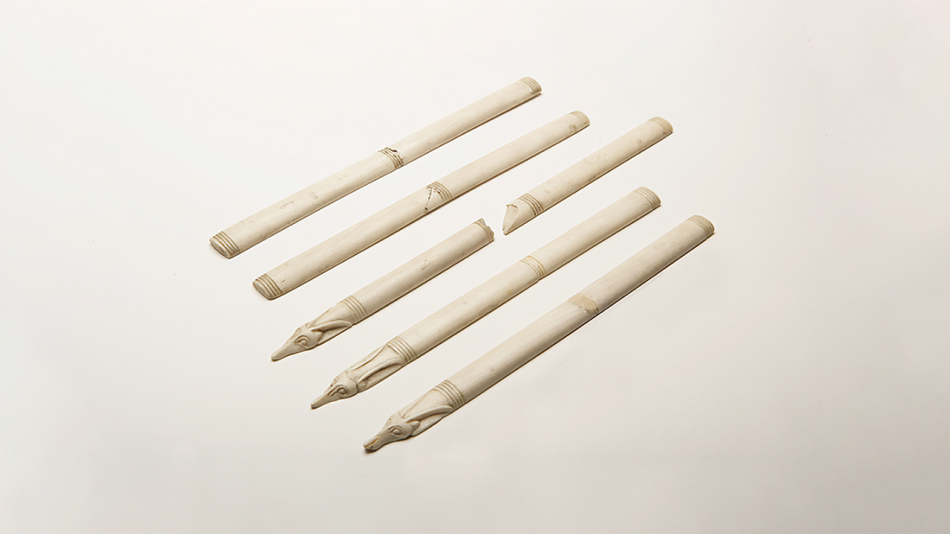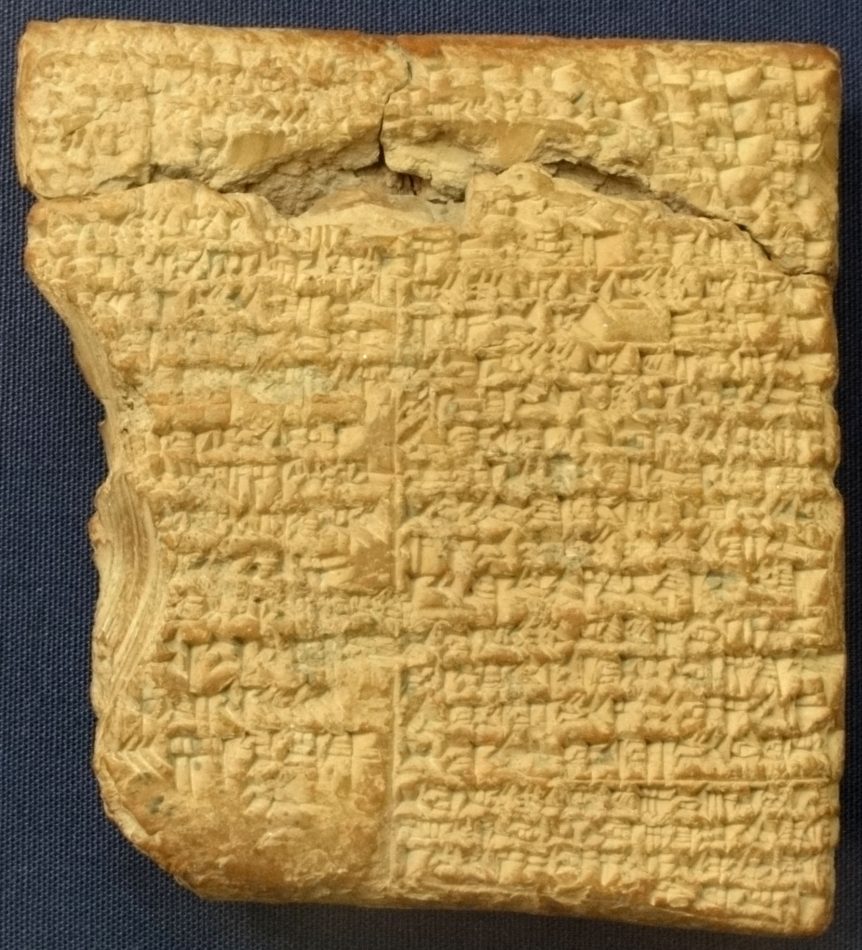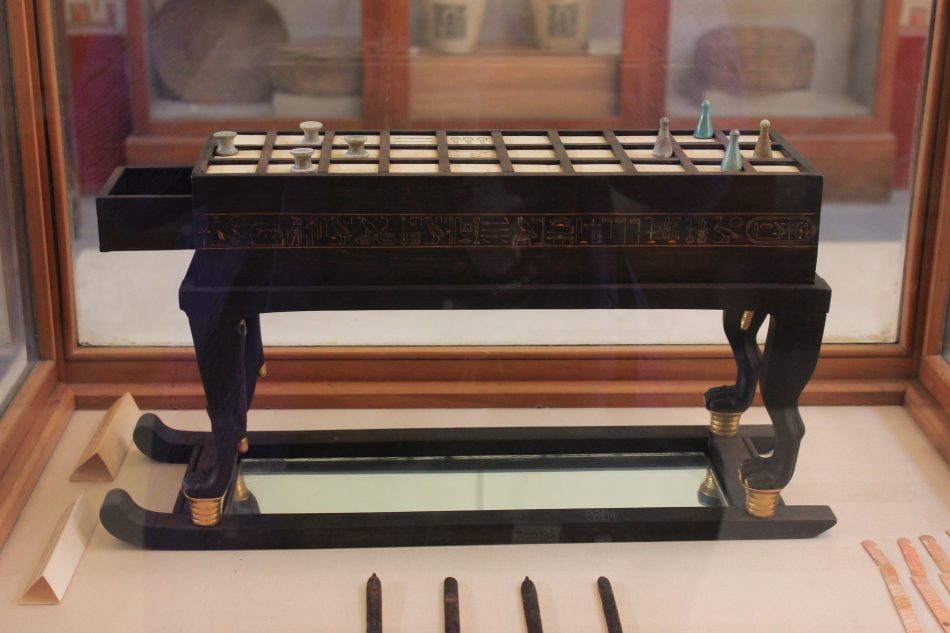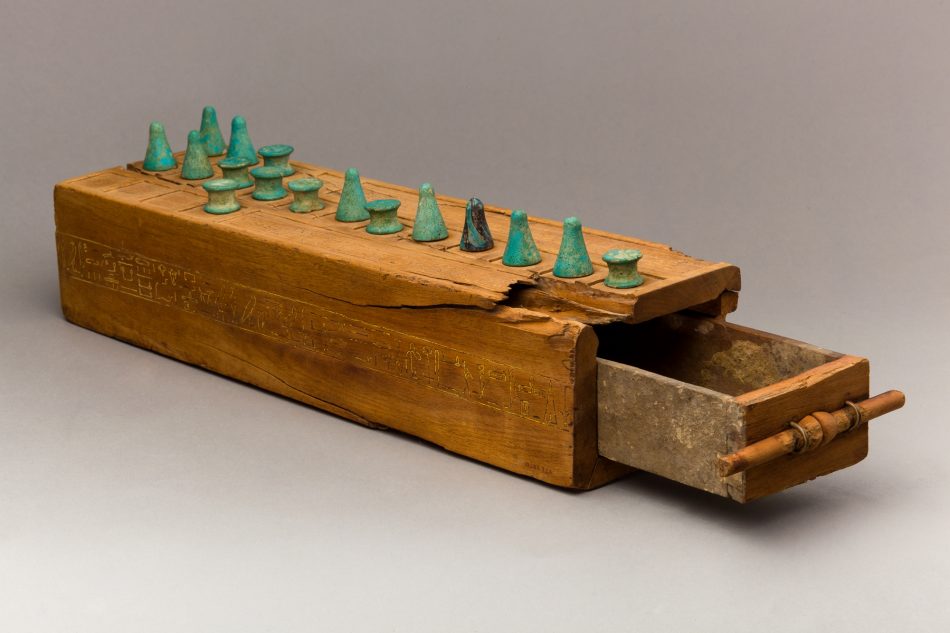The Earliest Roleplaying Game - Learning from the Egyptians
Much debate can still be generated by bringing up the question suggested by the title of this piece – the most usual answer is that roleplaying games begin in the dim dark past of 1974 with Dungeons & Dragons (commonly known as D&D or DnD). Those debates are not the purpose of this article, however, and I do not intend to inflame them. Instead, we are going to travel back far further than many RPG enthusiasts might imagine possible for their hobby in search of the origins of, perhaps, the original roleplaying game, to ancient Egypt, 5,000 years ago. Board Games First Board games were immensely popular in the ancient world, played all over the Near East and Egypt. Later, the Romans would introduce dice, six-sided cubes with, you guessed it, the numbers one to six on them (usually indicated by circles or dots). However, they also had twenty-sided dice (the icosahedron) used for divination – and these, lo and behold, either had the letters of the alphabet (the rarer letters were allocated two to a surface) or the numbers one to twenty. The most common RPG dice are still six-sided and twenty-sided die, the D6 and D20. Before dice, there were similar devices that seem to have been used to introduce a randomizing element to board games – throwing sticks – which were rolled but only had two sides (and also a head and tail on some surviving examples which may also have been significant).

Egyptian throwing sticks (© Manchester Museum)
Two board games, in particular, were immensely popular in ancient Egypt: mehen and senet. I make this blanket statement knowing that it is inaccurate – senet was popular from approximately 2600 BC for almost three millennia (or even more) whereas mehen was popular earlier, the first mention comes before 3000 BC, but the game became less popular around 2200 BC. The two games were therefore popular for centuries, even millennia, but only overlapped for a period of a few centuries in the third millennium BC. Senet remained popular for far longer (almost three millennia) and grew in popularity as mehen’s appeal declined (mehen's popularity ‘only’ lasted a little more than a thousand years). These games make the century of Monopoly (from 1903 as The Landlord’s Game, first published by Parker Brothers in 1935) pale into insignificance (and even make Chess look like a lesser-known game – Chess traces its origins back to the seventh century AD but the game we play is related to a fifteenth-century variation). Senet probably does not hold the title of longest-played game, however, that title probably goes to knuckle-bones. Nor were these the only games – we also have evidence of a game known as ‘men,’ another called ‘Hounds and Jackals’ (we do not know its ancient name – another modern name for it is ‘fifty-eight holes’ since the board consisted of two sets of twenty-nine holes), and the ‘Royal Game of Ur’ (so named because it was first found at the city of Ur and assumed to be a game played by royalty (because it was found in a royal tomb)). Alternative names for this game are the ‘Game of Ur’ or the ‘Game of Twenty Squares’ or just ‘Game of Twenty’ (reflecting the game board of twenty squares). Archaeology has provided us with many examples of the boards for these games in various contexts, images of the games being played, as well as actual game pieces and, in a few rare cases, the rules (we have the rules of the Game of Ur on cuneiform tablets). In some cases, we rely on modern reconstructions for how these games were played, but we can use a wide variety of information to suggest gameplay and also what the games meant to their players, and this is where mehen and senet should really appeal to (and be known to) modern Roleplayers.

The rules of the ‘Royal Game of Ur’ preserved on a cuneiform tablet (© Fae / Wikimedia Commons)
Gaming the Afterlife Both mehen and senet represent symbolic journeys through the afterlife. As they played, players could plot moves on the mehen and senet board that could foreshadow their future as spirits in the afterlife – an important consideration for all Egyptians after around 2,200 BC. Prior to that, the afterlife was the privilege of royalty but it now became a concern of all Egyptians. In art, we also see the souls of the dead playing games of mehen and senet. A recent article by Colleen Darnell in Ancient History 34 (‘Gaming the Egyptian Afterlife – The Significance of Mehen & Senet’), explores these games in greater detail. In addition to Darnell’s excellent introduction, we can also use the exploration of Walter Crist, Anne-Elizabeth Dunn-Vaturi, and Alex de Voogt (Ancient Egyptians at Play, Bloomsbry, Oxford (2016) and some other works (and reconstructions).

The Mehen snake (perhaps a game board although without squares) (© rob koopman / Flickr)
Mehen was the snake god of ancient Egypt who protected the sun god Ra in its coils on Ra’s daily journey through the netherworld until the following day’s sunrise. The name Mehen literally means “to coil” or “the coiled one,” and, for the surviving game boards of mehen that is indeed what we see: a coiled snake with its head at the centre of the board. The game was played on squares into which the snake’s body is divided. These boards could, however, coil clockwise or counter-clockwise, sometimes there is no head or tail, and the number of squares that the body was divided into vary (unlike the boards for the Game of Twenty which uniformly have twenty squares, the ‘Hounds and Jackals’ boards which all have two sets of twenty-nine holes, and every senet board has three rows of ten spaces). Sometimes on mehen boards, there are no squares at all, nor was the number of coils standardized. Surviving mehen boards vary from forty-nine spaces to four hundred. The earliest surviving board comes from a Naqada burial at Ballas (now in the Ashmolean Museum in Oxford) and dates to approximately 3250-3000 BC. Some boards are small and may have been amulets or votive offerings representing the game and the Mehen serpent at the same time. All of this variation occurs in only fifteen examples of the board – all that have been found.

A votive mehen game in the shape of a turtle (© Metropolitan Museum of Art)
Mehen We do not know the rules for mehen, but a tomb from around 2650 BC (the mastaba of the high official from the Third Dynasty, Hesy-re, in Saqqara, Egypt), shows a mehen board with thirty-six marbles (six sets of six of different colours) and six pieces shaped like couched lions and lionesses (three of each). The first time the game is named (mḥn) comes from the tomb of Prince Rahotep at Meidum (2613-2494 BC) – the tomb also names senet (zn.t) and another game, ‘men’ (mn). The three games boards and pieces are depicted on the walls of the tomb. In mehen, we think each player manoeuvred their lion piece around the board in a strategic race that may have included up to six players. Some boards show wear between the coils so the marbles may have been rolled around the coils. There do not seem to have been any dice-like devices associated with the game, however, although no full set of pieces has been found (the depiction on Hesy-re’s tomb is the only ‘full’ set depiction we have). The closest we come to a full surviving set is three lions and thirty-nine marbles, another find has a full set of lions and lionesses but only two sets of marbles (in red and white). There is evidence the game of mehen was widespread, played in Nubia and Cyprus too. As you played, however, you could (presumably) envision what your own soul might do in the afterlife and make the appropriate move on the board - this aspect links mehen with modern roleplaying.

A mehen board (© Daderot / Wikimedia Commons)
Although we do not possess the rules of mehen, we do have five artistic representations of the game being played from various tombs. Usually, these involve two players (the players are always men), but in them, marbles appear to be moved (not rolled) and no lion or lioness piece is shown on the board. We know they are playing mehen, however, since one hieroglyphic caption accompanying the depiction states “playing mehen.” Another has “I am playing mehen against you.” Another tomb (that of Kaiemankh at Giza) suggests the game in action showing us it was competitive; one player says “seizing mehen,” the other replies “I take aim at you and play towards you.” A different caption reveals nothing in gaming has changed down the millennia – “hurry up!” We think that the aim of the game of mehen was to reach the centre of the coils and perhaps there gain the protection of the Mehen serpent. The game was therefore connected to the Egyptian ideology of rebirth and afterlife associated with Ra’s journey through the underworld and your pieces may have represented your own soul. Later texts talk of the Roads of Mehen where nine concentric roads existed in the underworld. At the centre of these roads, Ra sat on his throne and the deceased needed to successfully navigate the way to Ra without falling to the dangers of the roads. Mehen last appears in a tomb from the First Intermediate Period (2181-2055 BC). The game may have become forbidden; we have coiled serpent boards which survive from later with no squares at all. This, it has been argued, was because the squares on earlier boards came to be considered an impious representation of ‘killing’ the Mehen serpent and so fell out of favour. Mehen’s demise also corresponds to the rise in popularity of senet. One possibility is therefore a kind of proto-system war, even edition-war (something roleplayers today understand all too well). As senet became more popular, mehen was not only overtaken in popularity (and eventually subsumed completely) but ideas against it were spread (it may have become a 'bad' game and was somehow wrong to play it). Senet The tomb of Prince Rahotep also marks the earliest mention of the game of senet and so the games overlap by some centuries. In many of the tomb finds, games of senet are also seen, and senet pieces are also found, many more than for mehen. Senet, however, continued to be popular long after mehen fell out of favour. Mehen seems to have been a game played on by the elite (only wealthy tomb depictions of it have been found); that is not to say that it was not played by people lower down the social scale, only that there is no evidence for it. For senet, however, we have boards from across a wider social spectrum. Some boards were carved crudely into rock surfaces, others are of the highest quality and depictions exist in royal tombs, as well as of individuals lower down the social scale which suggests the game was far more widespread and popular.

A senet board and pieces from the tomb of Tutankhamun (© لا روسا / Wikimedia Commons)
Senet boards are also far more uniform in design – all possess three rows of ten spaces. Surviving examples of senet boards are between 12 and 55 cm long. Several of the squares on senet boards are specifically marked as squares of significance (like a precursor to modern board games and indeed, roleplaying maps). Many more boards (and fragments of boards) exist for senet – some of these may not actually be senet boards, of course, especially the fragments. There are other games like the Game of Ur and 'Thirty-three' which these fragments may be from). A set of senet pieces from Abydos suggests that each player had seven tall and seven short conical pieces, fourteen pieces in total. Alternatively, one player may have used the tall pieces and the other the short ones. A later set of thirteen domed pieces (tall and short) might suggest a different number of total pieces. The tomb of Hersy-re shows two sets of seven domed pieces (seven short and seven tall) – which suggests the two sets of seven pieces were a complete set – along with four throwing sticks. Throwing sticks became the favoured ‘randomizing agent’ as a fore-runner to dice. Senet therefore probably involved throwing sticks and moving your pieces to the corresponding number of squares – a very late source names the pieces as ‘dogs’ (most commentaries call them pawns using Chess terminology). All of this sounds like standard board game mechanics (akin to Backgammon especially) although it is still remarkable that these ideas are 5,000 years old.
Squares of Significance On senet boards, however, we find specific symbols in specific squares and those squares clearly had a special significance for how the game was played and won. For example, the word nfr meaning “good” or “beautiful,” appears in square twenty-six; an X comes in square twenty-seven (meaning some kind of danger or hazard), the word “three” occurs in square twenty-eight and “two” in square twenty-nine. A couple of surviving examples have the word “one” occur in square thirty. Fifteen tombs show games of senet being played between two players sitting on opposite short-sides of the board and with all the pieces between them. Although players are usually male, we do find Nefertari playing senet (the thirteenth century BC queen of Pharaoh Rameses II seen above on the feature image of this blog). In his nineteenth Dynasty tomb, Sennedjem seems to play senet with his wife seated beside him (they may be playing together since it appears that there are two sets of pieces in play). Several depictions of senet show them in funerary celebrations dedicated to the goddess Hathor, goddess of love, beauty, music, dancing, fertility and pleasure, and the feminine counterpart to Ra and Horus. Hathor also protected Ra from his enemies (and so was a protection goddess, in gaming terms perhaps akin to the Mehen serpent). Like mehen, senet too was associated with the afterlife – the word means “passing” and had religious connotations (although in the game it may have also meant passing as in overtaking, just as it does in board games today). The presence of senet in funerary scenes also reinforces this association with the afterlife. In its earliest history, however, senet does not seem to have had explicit religious connotations – it may have taken them over as mehen fell out of favour. By the Middle Kingdom (1975-1640 BC), senet had taken on those same religious associations. Like the earlier game, you now played for the journey of your own soul – facing hazards along the way. The tactics of how you manoeuvred your pieces had an outcome in how your soul fared on its journey. In the Middle Kingdom, the X hazard now appeared in both square fifteen and twenty-seven, nfr in twenty-six, “three” in twenty-eight, and “two” in twenty-nine. The orientation of the board also seems to have undergone a change – the earliest boards had these markings in the bottom right corner of the board, from the Middle Kingdom they appear in the upper left corner (we have a total of nine surviving boards dating to the Middle Kingdom). We find boards painted on wood and scratched as graffiti. One depiction of a game (from the tomb of Khety at Beni Hasan) has the player state “playing five” which is an enigmatic reference to gameplay, perhaps meaning that they were moving their piece five spaces.

A senet game box from the New Kingdom (1550-1352 BC) (© Metropolitan Museum of Art)
The Coffin Texts, a collection of Egyptian funerary spells written on coffins, mention senet. Three spells mention the game – reaffirming its connection to the afterlife. One coffin from the necropolis at Meir (now in the Egyptian Museum) has the text “Let him play senet with those who are on earth.” A papyrus in the British Museum has another line of text, “when you shall be removed from the senet board.” This has been interpreted as the conception of the afterlife as a journey through the game of senet, or was life a game of senet (perhaps paralleled in souls playing the game (for their mortal selves?) in the afterlife. As such, these aspects of playing senet reinforce the affinity to more recent ideas associated with roleplaying games. This belief of a connection between senet and the afterlife became widespread during the New Kingdom (1550-1352 BC). During the New Kingdom we also find, for the first time, senet boxes – the board was now usually made with a drawer for the pieces (thirty of these boxes have survived, and eleven other boards from the New Kingdom also survive). In the New Kingdom, however, the orientation of the board reverted to what it had been in the Old Kingdom, with the decorated squares on the bottom right corner of the board (we do not know why). At the same time, the game became even more widespread – played in the Levant, Nubia, and Cyprus. The decorated squares also became more elaborate. The nfr, X, “three” and “two” squares remained in their usual places. However, these were sometimes replaced – X with mw, a marking associated with a water hazard. In a couple of surviving examples, the square is shown with a hippopotamus, in one the god Hapy, god of the inundation. That square was clearly therefore one to avoid (something the X had probably symbolised from the start). The nfr square now becomes nfrw and is sometimes shown as Ma’at (goddess of truth, justice balance and order) holding nfr. The “three” could be three men, the “two” two men; later still the “two” became “two gods” (ntrwy). Square thirty is now decorated with a sun disc representing Ra. These changes continued so that by the Twentieth Dynasty (1189-1077 BC) we find the final five squares are each associated with the gods – nfrw in twenty-six, Hapy in twenty-seven, ntrw “three gods” in twenty-eight, ntrwy in twenty-nine, and Horus in thirty. The three and two gods could even be specific deities – Thoth, Shu and Ma’at for the three and Ra and Atum for the two. Square fifteen (as we saw occasionally marked with an additional X earlier) now became marked with a checkered pattern or a rosette (see below).


Two sides of an Egyptian gaming box with Game of Twenty (top) and senet (bottom) – the senet board has no special squares marked (© Metropolitan Museum of Art)
Two examples of senet boards in Turin have a decoration in every square – and these seem to reflect the journey of the deceased in the underworld, recreating the passage of Ra in the underworld protected by the Mehen serpent. The End of senet and the long sleep The final reference to a game of senet occurs in the third century AD although by that time it seems the game was little understood. A board was described where the twenty-sixth square contained a “good house,” and square thirty was the “house of Horus,” but the board was interpreted as an astronomical device. It is possible the game was played locally but foreigners (Romans and Greeks) did not understand the rules.
In both of these Egyptian board games, although we do not possess an exact understanding of the rules as such, there was a clear idea that as you played, it was your soul that was being played for. The parallels of playing senet in the afterlife echo this. There have been several modern reconstructions of the game although these must use some degree of guesswork and later evidence to reconstruct earlier iterations of the game. Several of the squares in senet had specific religious connotations and the connections between these squares and their meanings, and the idea that the player’s pieces represented their own soul on a representative journey through the underworld, make the correlation to some modern roleplaying games obvious. The idea that the game represented the journey of the player as a religious process also reinforces the idea that this was more than a board game in the modern sense where there is little at stake for the player other than the game. The idea of a character in the game whose life or death your decisions affect has its closest cousin in the modern roleplaying game. Roleplaying Games are therefore much older than you think and have been part of the human gaming experience for nigh on 5,000 years.
